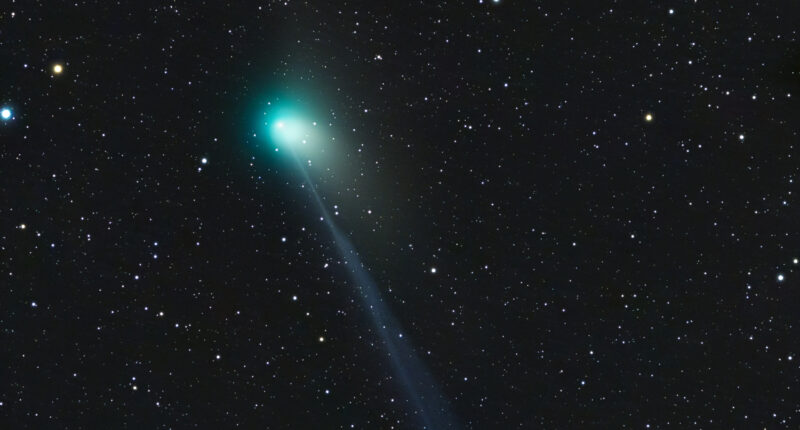THERE’S still time to see the Green Comet fly by Earth this weekend as it approaches the ‘golden star.’
Astronomers found the comet on March 2, 2022, by using a wide-field survey camera of the Zwicky Transient Facility at the Palomar Observatory in San Diego County, California.
The name refers to its blazing green tail, which is caused by a chemical reaction between the comet’s diatomic carbon molecules (C2) and ultraviolet radiation from the sun.
Even though the best time to see the comet was Thursday morning, there will be an opportunity to catch it on Saturday night.
This will be when the Green Comet approaches Capella, known as the “golden star.”
If Saturday is too foggy, the comet should be visible after sunset on Sunday, you’ll just need a pair of binoculars to see it clearly.
Follow our Green Comet 2023 blog for news and updates
-
What comets are made up of
The main components of comets include dust, ice, and gases.
However, determining the precise material makeup of the comet can aid researchers in learning more about the formation of our solar system.
The comet’s layers disintegrate under the Sun’s heat, making it easier for scientists to investigate its composition the closer it travels to the sun.
-
Other notable comets in history: The Great Comet of 1680
The comet was discovered on Nov. 14, 1680, by German astronomer Gottfried Kirsch.
What makes this comet special is it was the first comet discovered by a telescope.
It was reported from Albany, N.Y. that the comet could be seen in daylight passing above the sun.
The comet was deemed not visible to the naked eye by early February 1681.
-
Easily distinguishable
The comet’s streaking tails of dust and charged particles, as well as the brilliant green coma that surrounds it, can be used to tell it apart from the stars, according to CNN.
As a comet approaches the sun, a coma builds around it, causing its ice to sublimate, or transform instantly into gas.
When viewed through a telescope, the comet appears hazy as a result.
-
Comas, explained
The comet’s “coma” is the vast and incredibly thin atmosphere created by the jets of gas and dust that are so expelled.
A gigantic “tail” that points away from the sun develops as a result of the solar wind and radiation pressure of the sun acting on the coma.
Water makes up to 90 percent of the volatiles that escapes from the comet’s nucleus when it is within 3 to 4 astronomical units of the sun, making up the majority of the coma’s composition.
-
View the green comet livestream
The Cosmosapiens Youtube channel is hosting a live stream of the Green Comet’s arrival.
The caption below the video reads, “Green Comet also known as C/2022 E3 is getting brighter to become 2023 the best comet to watch live. Don’t miss this unique celestial event.”
This is the first time the comet is passing Earth in 50,000 years.
The last time the Green Comet was visible from Earth was when Neanderthals and early Homo sapiens roamed the planet.
-
How comets get named
It might be challenging to name comets, according to Nasa. In most cases, comets are named after the person or spacecraft that discovered them.
Only in the past century was this International Astronomical Union recommendation produced.
For instance, comet Shoemaker-Levy 9 was given that name because Eugene and Carolyn Shoemaker and David Levy discovered it as their ninth short-period comet.
Many comets include LINEAR, SOHO, or WISE in their names because spacecraft are particularly good at finding them.
-
Difference between comets, asteroids, and meteors, part concluded
The Quadrantid meteor shower is one example of this.
The celestial display occurs because the Earth passes through the trail of an asteroid or possible rock comet called 2003 EH1.
Small bits of debris fall off asteroids and comets and if this debris comes into contact with the Earth’s atmosphere at speed then it burns up.
This becomes visible as bright streaks across the sky, which are also known as shooting stars.
-
Difference between comets, asteroids, and meteors, part three
“When a comet’s orbit brings it close to the Sun, it heats up and spews dust and gases into a giant glowing head larger than most planets,” Nasa continued.
“The dust and gases form a tail that stretches away from the Sun for millions of kilometers.”
Meteor showers can form when Earth’s orbit takes it through the tail of a comet.
-
Difference between comets, asteroids, and meteors, continued
Nasa adds: “Asteroids are smaller than a planet, but they are larger than the pebble-size objects we call meteoroids.
“Most asteroids in our solar system are found in the main asteroid belt, a region between Mars and Jupiter.”
As for comets, the US space agency has a more icey explanation.
Nasa says: “Comets are cosmic snowballs of frozen gases, rock and dust roughly the size of a small town.
-
Difference between comets, asteroids, and meteors
The main difference between asteroids, comets, and meteors is their size and what they’re made of.
Nasa says: “An asteroid is a small rocky object that orbits the Sun.
“A meteor is what happens when a small piece of an asteroid or comet, called a meteoroid, burns up upon entering Earth’s atmosphere.”
-
What happens when a comet gets too close to the sun
When a comet gets close to the Sun, some of the ice starts to melt and boil off, along with particles of dust, according to nineplanets.org.
These particles and gases make a cloud around the nucleus, called a coma, which can extend between hundreds to thousands of km.
The nucleus is the solid core structure of a comet, no larger than a few km, and it is composed out of rock, dust, water ice, and frozen carbon dioxide, monoxide, methane, and ammonia.
-
Some comet facts, part V
Planets sometimes travel through a comet’s tail which causes what’s known as meteor showers, according to nineplanets.org.
Most meteor showers on Earth are caused by comets, such as the Quadrantids, Lyrids, Perseids, Orionids, Leonids, or Geminids meteor showers.
-
Some comet facts, part IV
Comets will occasionally crash into one another thus changing their direction, and throwing them out toward the inner solar system, nineplanets.org reported.
When a comet approaches the inner planets, it is warmed by the Sun.
It begins to melt and throws out dust and gas creating a head and a tail.
The tail always points away from the Sun and the head points towards it.
-
Some comet facts, part III
The Oort Cloud and the Kuiper Belt are way out in the Solar System, very far away from the Sun, according to nineplanets.org.
To this very day, the Oort Cloud hasn’t even been directly observed.
A comet spends the majority of its life in either the Kuiper Belt or the Oort Cloud.
-
Some comet facts continued
Like asteroids, comets are leftovers from the formation of the Solar System.
Many Scientists believe that these small bodies can hold many clues as to how our Solar System came to be.
Comets come from what is known as the Kuiper Belt and the Oort Cloud, nineplanets.org reports.
-
Some comet facts
Comets, unlike other small bodies in the Solar System, have been known since before the Middle Ages according to nineplanets.org.
Ancient Chinese astronomers used to keep extensive records and illustrations about comets that have contributed to modern astronomers’ studies and observations.
The word “comet” comes from the Greek word “Kometes” which translates to long hair. This is because of how a comet’s tail can look like long flowing locks of hair.
-
Some fun facts about telescopes
The first telescopes were used by sea merchants and the military.
Most observatories are built on mountaintops where the air is thinner and cleaner.
A lot of astronomers today work remotely from the actual telescope. They control the telescope using computers over the internet.
-
Where they come from
Beyond Neptune, where a swarm of dark comets orbits the Sun in the region of Pluto, there is a disc-like belt of frozen bodies, according to an idea put forth by astronomer Gerard Kuiper in 1951, Nasa reported.
The short-period comets are formed when these frozen objects are occasionally pulled by gravity into orbits that bring them closer to the Sun.
They orbit the Sun in fewer than 200 years, and because they have already gone by, their appearance is frequently predictable.
Long-period comets, many of which originate from the Oort Cloud region roughly 100,000 astronomical units from the Sun, are less predictable.
It may take these Oort Cloud comets up to 30 million years to make one round of the Sun.
-
Experts predict the comet’s next move
Researchers at the Zwicky Transient Facility, part of the California Institute of Technology’s Palomar Observatory, spotted the comet when it just inside Jupiter’s orbit – around 399million miles away from the Sun.
Scientists expect the comet to pull away from Earth and zoom back into deep space after making its closest swoop toward our planet at the beginning this month.
-
Once-in-a-lifetime comet passing Earth
Starting this week, a comet will pass by Earth for the first time in 50,000 years.
When Neanderthals and early Homo sapiens roamed the planet, the green comet last made this journey.
-
Meet C/2022 E3
The comet was found on March 2, 2022, by astronomers using the wide-field survey camera of the Zwicky Transient Facility at the Palomar Observatory in San Diego County, California.
The comet was closest to the sun on January 12, Nasa reported.
According to The Planetary Society, the comet with the designation C/2022 E3 (ZTF), per Nasa, has an orbit around the sun that travels through the outer regions of the solar system, which explains why it has taken so long for it to pass by Earth once more.
-
Other notable comets in history: The Great Comet of 1680
The comet was discovered on Nov. 14, 1680, by German astronomer Gottfried Kirsch.
What makes this comet special is it was the first comet discovered by a telescope.
It was reported from Albany, N.Y. that the comet could be seen in daylight passing above the sun.
The comet was deemed not visible to the naked eye by early February 1681.
-
If clouds get in the way of viewing parties
The Virtual Telescope Project will webcast a live feed of the comet in the skies above Rome if clouds or bad weather prevent skywatching.
But photos from the James Webb Space Telescope will not be a possibility.
The Telescope will be keeping an eye on the green comet, but it won’t be taking any pictures, Nicolas Biver, an astrophysicist at the Paris Observatory told France 24.
This post first appeared on Thesun.co.uk










